Recent Fire Damage Posts
Decorating Basics for Fire Safety
11/2/2022 (Permalink)
 Decorating Basics for Fire Safety | SERVPRO® of McAllen
Decorating Basics for Fire Safety | SERVPRO® of McAllen
Isn’t this a beautiful picture: twinkling lights, sweet smells of warm pies and gentle music playing everywhere you go? This time of year there is always something to do around here, including the evening parade, catching a concert or walking through the Christmas village at the park.
The holiday season can be pure magic, but it also can be a dangerous time for home fires.
Carefully decorate this season and take action to protect your home. Enjoy the wonder and awe of the season when you have taken the time to be fire-safe for both your loved ones and your community!
Top Seasonal HazardsOn average, fire departments respond to 790 fires that start due to decorations.
Often, decorations that are placed too close to a heating source like a space heater or fireplace are to blame for blazes. Candles and decorative trees are another leading cause of fires that can leave your home with extensive damages.
If you keep a live tree in your home, water it often so it doesn’t dry out and clean up loose needles that fall around it. If an artificial tree better fits your home, ensure it has a fire-resistant tag.
If it is several years old, consider replacing it to meet the highest safety standards. Don’t plug excessive items into your outlets and turn your decorations off when you go to bed.
Take Preventive MeasuresYou know that story that has the great line “The stockings were hung by the chimney with care? Say that over and over again while you hang decorations around your home and take care to avoid placing items close to an open flame.
Every day, there are an average of 20 home fires that start due to a candle. Blow them out when you leave the room, and burn them safely away from everything. If you have a fireplace, get it inspected and cleaned early in the season before you light it for the first time.
Any decorations for outside should be rated appropriately to be safely used in all kinds of weather. String lights need to be hung well with insulated nails so they do not fall and increase your risk of brush fires. Check local guidelines in your area for fire restrictions that may dictate outdoor safety rules, and be sure to heed them to protect your community.
Check your smoke detector’s batteries while you decorate, and be sure you have several working ones throughout your home. Talk about your emergency fire plan with everyone who may be staying with you for the season, and make note of SERVPRO’s number so you can make a quick call if your home is damaged during a fire.
Have smoke or fire damage in your house? Contact us today to get cleaned up fast.
Fire Prevention 101 with SERVPRO of McAllen
7/4/2022 (Permalink)
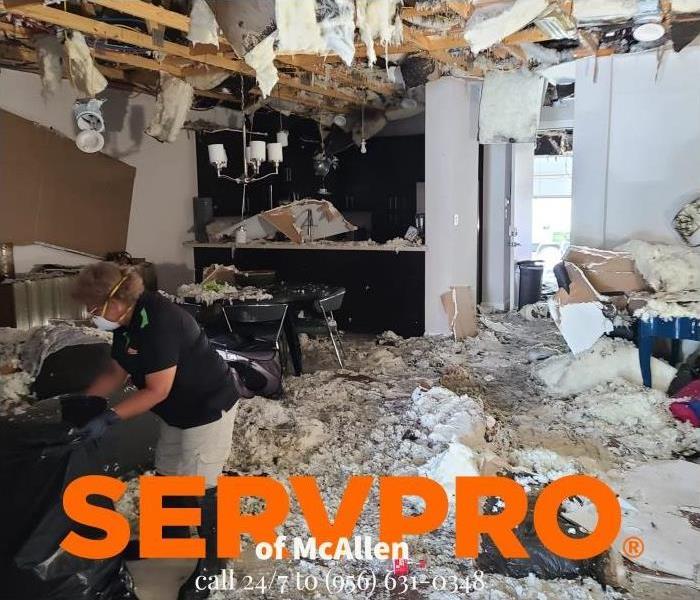 Have Questions about Fire, Smoke, or Soot Damage?
Call Us Today – (956) 631-0348
Have Questions about Fire, Smoke, or Soot Damage?
Call Us Today – (956) 631-0348
There have been more than 20,000 house fires that the American Red Cross has responded to this year, and that is only a portion of the total number of fires that have occurred in the United States.
Smoke detectors will always be the best way to prevent damage and the loss of life, but there are a few other things you can do that can provide protection to your home and your loved ones, even some that are as simple as cleaning up.
Clear the Clutter
Clutter is likely something we all fight on a regular basis already, but it can actually create a fire hazard. Allowing hallways, stairways, and utility spaces to fill with unused items can not only block emergency exits but also provide fuel to the fire.
Leaving loose clothing near a water heater can actually start a fire. Keeping your space clear means quick access to escape routes in the event of an emergency and can also slow down the progression of flames.
Another common source of fire in the home is overloaded extension cords. Remove any unused electronics and unplug appliances that you don’t use on a regular basis.
Take a look around your home and ensure that there is space between your walls and furniture. This allows for proper airflow to prevent overheating.
Create a Defensible Space in Your Yard
The area around your home is key in providing protection from fires that originate outside. Using strategically placed landscaping protects your home and gives room for firefighters to work in the event of an emergency.
Some states like California have imposed defensible zone regulations because this is such an effective way to slow the spread of a wildfire. With our dry climate that creates such a potential for grass fires, this type of landscaping is smart for us, too. In January, we saw five acres burn after a grass fire started, and the windy and dry conditions spring brought kept us on a constant watch for fire.
Intentional landscaping doesn’t mean you can’t plant the annuals you want; instead, it means using intentional placements of your plants and trees to provide the best protection. You should always keep your yard clear of dead plants, leaves, and limbs as these can strengthen a fire.
Power Strips and Surges with SERVPRO of McAllen
1/6/2022 (Permalink)
Surge protectors are great because they provide several outlets and that can come in very handy. However, depending on what you’re plugging in, not every outlet should be used. Most things we tend to plug in are like a phone, computer, or gaming console, which don’t use much power. Items found in your kitchen, on the contrary, such as a toaster, crockpot, or skillet would draw more power and could potentially cause electrical issues.
If the power strip or surge protectors begin to feel hot, it is a sign that you have too many things plugged in and should start unplugging to play it safe.
Watch for burn marks or melted plastic that would also indicate that there are to many things plugged in.
Before plugging in your next electronic device, look at what’s going on with your power strip or surge protector.
If in the event something does go wrong and you suffer from an electrical fire you can count on SERVPRO of McAllen. This type of damage can be especially upsetting and destructive for your family to process. You may feel stressed, confused, and vulnerable so you’ll need a caring expert to guide you through this crisis. We’ll treat you with respect, and empathy, and we’ll always treat your home and belongings with care. We will work nonstop until we get your life back to normal.
Fire Evacuation Plans for Childcare Centers
1/6/2022 (Permalink)
Did you know? US Fire Administration claims an estimated 325 fires occur in daycares annually. With that being said we believe that having and practicing an evacuation plan would be ideal to avoid and prevent any serious injuries and accidents in the event of a fire.
When it comes to fires there’s a storm of questions running in your head especially when having a building filled with children. Did everyone make it out okay? Where there any visitors in the building? Who called in sick today? All of these questions require for a quick answer even in the middle of all the commotion. Remember were talking about kids here and removing a building filled with kids at the same time. There’s no room for error or second-guessing. This is where a well-practiced evacuation plan can be the difference between having everyone out in time or not.
Ideally the goal is to have a strategized plan before opening to begin with. Everyone must understand their role and be able to identify which caregiver will be responsible for which children. Children who don’t yet walk ideally are distributed evenly among the caregivers. Keeping multiple copies of a parent phone tree through out the facility will also help when trying to communicate with parents. (Assure this list is kept updated and current) Your caregivers should be able to know how to use a extinguisher in the event its necessary to use. There should be 2 exits in every room in the building. Sometime a window may be the only option as a way out, assure there’s a way for the kids to safely evacuate through that window if necessary. Parents should be able to know how to locate you in the event of a relocation. Designate primary and secondary assembly locations. During a fire it is important that overall, you try to remain calm and follow protocols at all times, and call 911 from the secure location. DO NOT re enter the building unless the fire department says its safe to go back in there. Once all employees and children have been safely evacuated, begin checking the attendance roster. Once that is done you may now begin contacting parents after that, call your local SERVPRO for help with your insurance claim process and we can start on the clean-up and restoration process.
Fire safety for kids
11/5/2021 (Permalink)
Parents! Teaching your kids the importance of knowing fire safety is something that has to be taught on a yearly basis. As kids grow, they might forget what they learned 2-3 years ago by you going over and over this information it’ll stay fresh in their mind.
Here’s a safety checklist you can follow with your kids:
~ never play with fire
~ show the kids where the alarms are
~ replace 10 year alarms
~ test alarms every 6 months
~ have a list of emergency contacts nearby, eye sight level
~ practice stop drop and roll (covered face at all times with hands )
Children can easily get distracted and forget a set or 2 under difficult scenarios it’s important to teach them to stay calm.
Use Caution with Holiday Lights This 2021
11/1/2021 (Permalink)
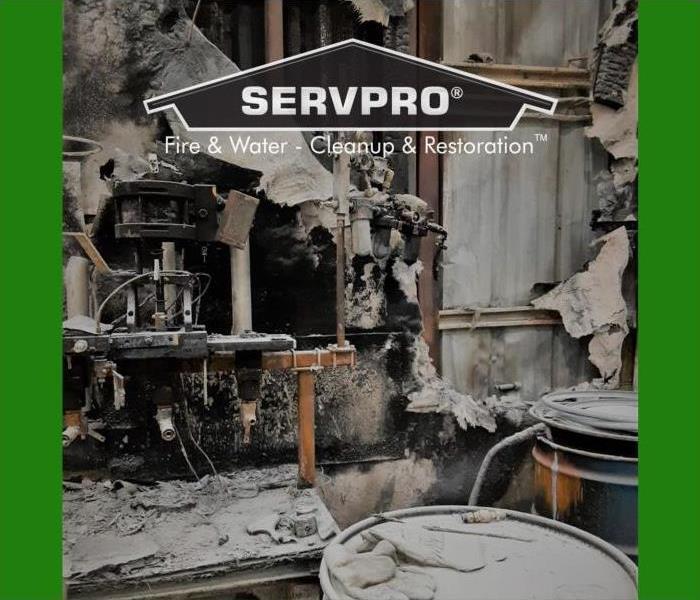 Have Questions? Call Us Today – (956) 631-0348
Have Questions? Call Us Today – (956) 631-0348
Lights are a staple for decking the halls. When used improperly, however, they create a fire hazard.
Keep some of these suggestions in mind when decorating;
- Purchase lights tested by underwriters’ laboratories.
- Dispose of lights when cords begin to fray or look worn.
- Go over the instructions to know how many strands can be connected together. Use extension cords sparingly to avoid overloading a circuit.
- Use indoor lights indoors and outdoor lights outside.
- Turn your lights off before heading to bed.
- Hang lights with plastic clips, because nails can damage lights causing a fire risk.
We’re Faster to Any Size Disaster. Immediate action is crucial when dealing with fire damage. We’re dedicated to responding immediately when you need help. A fast response helps lessen the damage, limits secondary damage, and reduces cost. CALL NOW, 956-631-0348, for more information on our fire clean up and restoration process.
One Spark, One Fire, One Team; We are HERE to HELP!
10/19/2021 (Permalink)
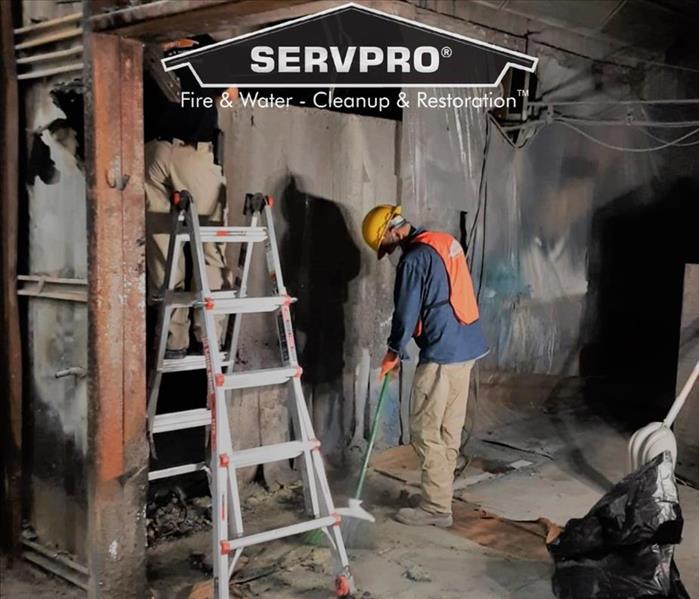 We proudly serve McAllen, TX, and surrounding areas. If you have any additional questions about fire, smoke, or soot damage? Call (956) 631-0348
We proudly serve McAllen, TX, and surrounding areas. If you have any additional questions about fire, smoke, or soot damage? Call (956) 631-0348
When it comes to fires, we all know what to do. We call 911 and follow our fire escape plan or simply go to a safe area away from the fire. Right? But what happens after the fire, what do YOU do after the firefighters have left your property?
Simple. Call SERVPRO of McAllen, that’s where we step in. You see there's nothing you need to worry about when you contact our team of professionals who, when it comes to fires, are 110% ready and high trained. Our technicians handle everything from;
-Emergency Contact
-Inspection and Fire Damage Assessment
-Immediate Board-Up and Roof-Tarp Service (if needed)
-Water Removal and Drying (if water damage is present)
-Removal of Smoke and Soot from All Surfaces
-Cleaning and Repair
-Restoration
Trust in SERVPRO of McAllen we are locally owned and operated—so we are part of the McAllen community too. We are also part of a national network of over 1,700 SERVPRO Franchises and special Disaster Recovery Teams strategically located throughout the country to respond to large-scale disasters.
Fire Safety for Kids!
7/5/2021 (Permalink)
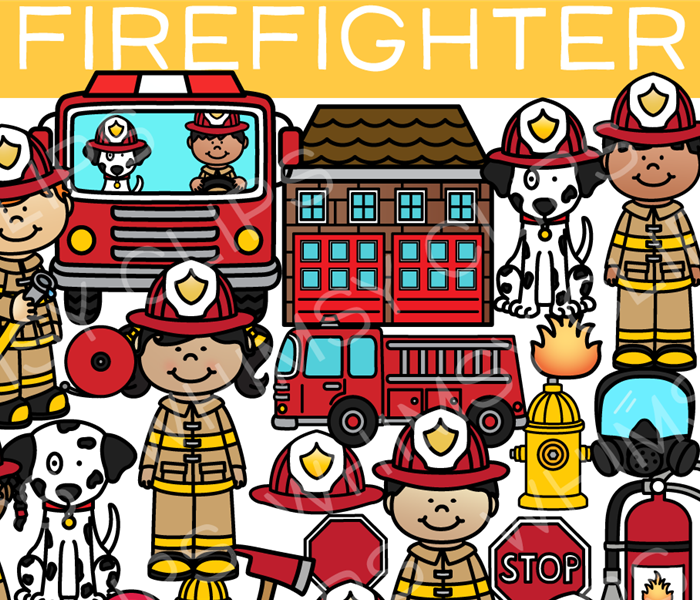 Call us today, (956) 631-0348, for your FREE quote!
Call us today, (956) 631-0348, for your FREE quote!
Although the thought of our children going back to school might be lingering in the air, that may not be quite the scenario just yet. With summer school ending in most school, at this point in the summer, we all have our homes busy with the little pitter patters of our little ones. Take a moment during this down time you have and go over some safety tips with them! Give yourself the peace of mind knowing they know what steps, and directions, to follow in the event of a FIRE!
First things first, you want to have an escape plan ready. It's important to provide and easy escape route for children, for they sometimes need help in getting out of the house. They may not know what to do, or how to, unless an adult shows them so.
- Have a plan ready for children who cannot go outside by themselves. In this scenario, if you have younger children or babies who can’t exit without the actual help of someone, talk to one another to know who will help each child to safety.
- It's important to have 2 ways out of each room in your home, in the event one exit is blocked or not safe to exit from.
- Have a meeting place outside your home. Kids should know what to do when they hear a smoke alarm and they are alone. Help them practice going to the meeting place, and discuss the importance of never going back inside a building, that is on fire.
We don’t want to think of our children being put through such scenario, but unfortunately the possibilities aren’t zero. For the safety of our kids, (peace of mind to us, the parents) it's always better to be extra prepared!!
In the event your home suffers from any fire damage, call SERVPRO (insert franchise) .At SERVPRO, we understand family means everything. When you’re a family-owned franchise you want to be able to provide this feeling of safety and peace of mind. We are here to help you! To help restore your home, and RESTORE you that feeling of safety back! When we provide 24/7/365 service, it isn’t hard to do either!!
Tips for Fireplace Safety
1/7/2021 (Permalink)
A poorly maintained or improperly used fireplace can be dangerous. Here’s how to enjoy your fire safely.
4 tips for fireplace safety
1. Have your fireplace cleaned and inspected regularly
According to the National Fire Protection Association, 28 percent of heating fires are caused by failing to clean equipment, especially chimneys. Over time, creosote (a sticky, flammable substance that’s released when wood’s burned) can build up in the chimney. If the creosote isn’t removed, a chimney fire can result. This is not only dangerous in itself, but it can also cause damage to the chimney, increasing the risk that flames will reach the frame of the house.
Debris such as fallen leaves and animal nests should also be removed, since they can restrict airflow and cause carbon monoxide to back up into the house. (Besides, if your chimney’s blocked, how’ll Santa get in?)
If you have a wood-burning fireplace or stove, you should have the chimney professionally inspected at least once a year (before you use it). Ask for a Level 1 inspection, which involves a visual examination of readily accessible parts of the chimney. The inspector will ensure the chimney is sturdy and perform any necessary cleaning.
Have a gas fireplace instead of a wood-burning one? You should still get a regular inspection, as corrosive deposits can build up and prevent your fireplace from venting efficiently. Debris can block this type of chimney as well.
2. Burn only dry, seasoned wood
Properly seasoned firewood contains around 20 percent water. Freshly cut wood can contain up to 45 percent water, so it takes a lot of heat to get it to catch fire (which means less heat inside your house). Burning wet wood also creates large amounts of smoke and causes creosote to build up more rapidly.
To be properly seasoned, firewood must be cut to length and allowed to dry for at least 6 months (up to a year in damp climates) before being burned. If you’ve gathered a stockpile of wood, be sure to protect it from rain and snow. If you’re buying wood to burn, look for dark edges with visible cracks. Well-seasoned firewood’s fairly lightweight and makes a clear, sharp sound when clapped together.
Resist the temptation to toss wrapping paper, cardboard boxes, or foam containers into the fireplace. Paper and cardboard can cause flames to burn too high, while foam releases toxic smoke and particles into the air.
3. Make sure your damper’s properly adjusted
The fireplace damper is a plate or valve that controls airflow in your chimney. When the fireplace isn’t in use, keep the damper closed completely to prevent heat from escaping. When lighting the fire, open the damper wide to help create a good blaze and get smoke flowing up the chimney. Once the fire’s burning well, partially close the damper to keep in warmth while still allowing smoke to escape.
4. Install and regularly check carbon monoxide detectors
Burning wood creates carbon monoxide (a poisonous gas) — but this poses little danger if your chimney’s properly maintained and free from obstructions and if your damper’s letting smoke out. Nonetheless, it’s wise to install smoke and carbon monoxide detectors close to your fireplace as well as in your bedrooms.
Now that you know how to use your fireplace safely, you can relax, toast some marshmallows, and find other way to winterize your home.
Understanding the Risk of Carbon Monoxide Poisoning
1/7/2021 (Permalink)
Each year in America, unintentional carbon monoxide poisoning claims more than 500 lives and sends another 15,200 people to the hospital emergency rooms around the country for treatment. These accidents tend to peak during the winter months, but there are several everyday items that can put you and your family at risk, too. Read on for some simple steps you can take to help protect yourself or your customers from deadly carbon monoxide fumes.
What is Carbon Monoxide?
An odorless, colorless and toxic gas, carbon monoxide cannot be seen, tasted or smelled. Since it is often impossible to detect, CO can cause harm or become fatal before you realize it is in your home. When exposed to lower levels of CO, the gas causes mild effects that are often mistaken for the flu, including headaches, dizziness, disorientation,nausea and fatigue.
It's also important to note the effects of CO exposure can vary greatly from person to person depending in age, health, and the concentration and length of exposure.
Where does it come from?
- Gas-fired appliances
- Charcoal grills
- Wood-burning furnaces or fireplaces
- automobiles
Preventative Measures
Consider installing at least one carbon monoxide alarm with an audible warning signal. The ideal placement for these alarms is near the sleeping areas of your home. Since CO alarms measure CO levels over time, the alarm will sound before an average, healthy adult would be experiencing symptoms. If you are not experiencing symptoms when the alarm sounds, please consider ventilating the home and contacting a service professional to check the CO level. If you are experiencing symptoms of CO poisoning, experts say to evacuate immediately and contact emergency personnel.
If you drive a vehicle with a tailgate or rear hatch and are travelling with he hatch open, make certain to open vents or windows to create adequate airflow. And, of course, never run your vehicle inside your garage with the door closed. Even with doors open, refrain from running your vehicle for extended periods of time, as garages with a door on only one side often do not provide adequate air flow.
Electric Fire Prevention For the Winter Season
11/6/2020 (Permalink)
 Christmas Lights Hanging on Homes Roof
Christmas Lights Hanging on Homes Roof
The holiday season is in full swing and homeowners will decorate their homes inside and out with an assortment of lights and decorations to contribute to the overall atmosphere of the residence. With the hustle and bustle of the Christmas season, it is very easy to lose track of everything going on; forgetting the finer details that will help the family, and keep a safe home. Increasing the electrical utilization of a home inevitable increases the likelihood of any residence catching on fire and following these tips may equip to fully enjoy this holiday season.
All electrical equipment purchased or utilized is required to have a statement on the box stating this equipment is acceptable to use by the federal government. Utilizing government-approved equipment for decorations is a key step and not doing so can put familys at risk. If the equipment instructions specify for indoor or outdoor use it is paramount to follow those instructions and not just take it under advisement.
Be sure when setting up lights and decorations that they’re placed away from any standing water or snow to reduce the risk of causing an electrical fire to any residence. The placing of electric equipment near any standing water may also cause electrocution. Also, keep any Christmas decorations away from community power lines to reduce the likelihood of over-usage.
Lastly, turn off the Christmas decorations or unplug them completely when sleeping or leaving any residence for an extended period of time. Although an inconvenience the inability to respond immediately if a fire was to occur when the amount to more damage overall.
Did You Know There are Four Different Types of Fires?
11/6/2020 (Permalink)
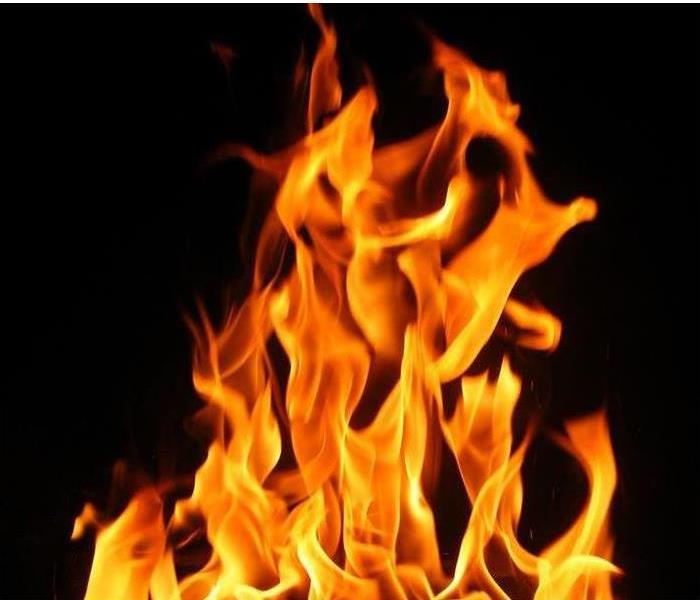 Flames Grow During the Stages of a Fire
Flames Grow During the Stages of a Fire
By basic definition, Fire is the rapid oxidation of a material in the exothermic chemical process of combustion, releasing heat, light, and various reaction products. (Slower oxidative processes like rusting or digestion are not included by this definition)
By most standards including according to the International Fire Service Training Association (IFSTA), there are 4 stages of a fire. These stages are incipient, growth, fully developed, and decay. The following is a brief overview of each stage.
Incipient – This first stage begins when heat, oxygen and a fuel source combine and have a chemical reaction resulting in a fire. This is also known as “ignition” and is usually represented by a very small fire which often (and hopefully) goes out on its own before the following stages are reached. Recognizing a fire in this stage provides your best chance at suppression or escape.
Growth – The growth stage is where the structures fire load and oxygen are used as fuel for the fire. There are numerous factors affecting the growth stage including where the fire started, what combustibles are near it, ceiling height, and the potential for “thermal layering”. It is during this shortest of the 4 stages when a deadly “flashover” can occur; potentially trapping, injuring, or killing firefighters.
Fully Developed – When the growth stage has reached its max and all combustible materials have been ignited, a fire is then considered fully developed. This is the hottest phase of a fire and the most dangerous for anybody trapped within.
Decay – The longest stage of a fire, is usually the decay stage. It is characterized by a significant decrease in oxygen or fuel, putting an end to the fire. Two common dangers during this stage are first – the existence of non-flaming combustibles, which can potentially start a new fire if not fully extinguished. Second, there is the danger of a backdraft when oxygen is reintroduced to a volatile, confined space.
If you’re home or business has experienced fire damage then call us, SERVPRO of McAllen at 956-631-0348. We are available 24/7 and 365 to assist you with cleaning up, salvaging, and restoring your property.
How can residents Deal With House Fires
10/30/2020 (Permalink)
What Methods Reduce Fire Losses?
a property fire in your Mission home can be a harrowing experience. Many items in your house hold can become permanently damaged or ruined by soots, odors, and smoke residue. Structural soiling can often be impossible to remove without using cutting-edge cleaning technologies and methodology. We understand that the residents need to continue with their lives regardless of fire-incidents and work with you to minimize personal disruption.
Why are subcontractors enlisted for Fire Damage recovery?
Subcontractors are often enlisted for the following;
- A building or general construction expert may need enlisting when significant parts of a structure sustain a large amount of damage.
- Remodelers and architects are usually reserved for the most extreme fire loss scenarios but can sometimes be necessary.
- Electricians are used to re-circuit or restore power to a home if there is damage to the fault box or wiring.
Are Subcontractors essential to fire loss recovery?
It can be frustrating to need multiple services for fire damage in your mission home. Numerous subcontractors are not required as SERVPRO technicians can perform extensive cleaning, restoration, and deodorizing tasks in many situations. In specific instances enlisting a subcontractor may be critical to returning your home to its preloss condition. We can enlist trusted third-parties on your behalf and task them with their specific requirements, such as artwork restoration or remodeling.
What considerations are useful for subcontracting?
- The infrastructure of the vendor including location, expertise, insurance, licensing, and financial stability.
- Vendor reputation for outstanding work and quality.
- Verifying subcontractors by using the better business bureau, city council, or the contractor license board.
What is the Best Way to Restore Fire Damaged Cabinets?
5/15/2020 (Permalink)
Cabinet Restoration for Kitchen Fire Damage in your Home
Leaving a stove unattended in your kitchen can be a prime cause of house fire. High temperatures can result in animal fats or other forms of grease to ignite, resulting in rapid naked flames, which can damage both the stove as well as the immediate surrounding area. Often you may see severe blackening on the ceiling directly above the stove as well as soot or smoke residues on cabinets. Since hot smokes seek out cooler areas, there is a strong chance that interior cabinets may become soiled with smoke damages.
The impact of kitchen fire damage in your home is likely to concentrate on appliances and fittings in the immediate vicinity. Removing these soots can be tricky without the requisite experience in dealing with different types of material and different types of smoke. Heat and pressure may also wear away finishes both on appliances and cabinet. These can then expose surfaces to soots, which can become ingrained. SERVPRO technicians recommend that homeowners not repair, clean, or restore the surfaces and walls before an inspection by professionals.
While SERVPRO promise to arrive on-site within four hours of notification of loss, many homeowners may attempt to repair some damages themselves. We recommend that you lay down any protective sheeting like tarpaulin or old bed linen on surfaces and floors in the affected area. This process can help to prevent falling soots from causing damage. Minimizing foot traffic in the affected area may also be a useful consideration for homeowners while awaiting professional assistance.
In performing kitchen fire damage restoration, the first task of our restorers is to decide which items are salvageable and which are not. The outer layers of your cabinets may become charred beyond repair, in which case SERVPRO technicians may need to remove and dispose of the offending areas. Other aspects of a fitting may respond well to restoration. SERVPRO technicians can use sandblasting equipment to remove surface layers and embedded soots before re-finishing the surface appropriately. We always conduct pre-testing of materials before cleaning solutions, or other chemicals are applied to avoid causing further harm.
Some Warning Signs of Fire Damage Issues in the RGV.
1/6/2020 (Permalink)
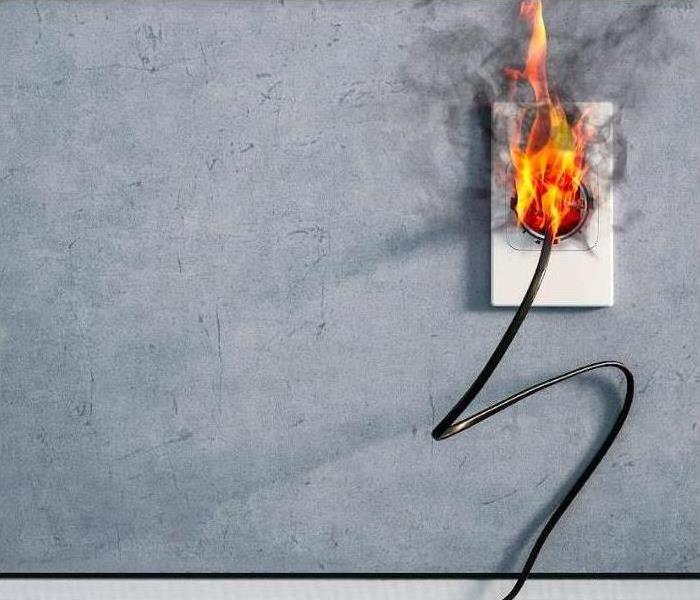 Whether the fire damage stems from an electrical issue or started in a different way, team SERVPRO has you covered. Call today.
Whether the fire damage stems from an electrical issue or started in a different way, team SERVPRO has you covered. Call today.
Something that no homeowner expects to happen is a fire, but this is often an unfortunate and tragic event. Few emergencies are as catastrophic and costly as a house fire, but it can help to hire trained professionals to assist with the restoration process.
To address fire damage in McAllen, you can trust our team at SERVPRO. We have trained restoration professionals that work hard to clean the soot and smoke left behind after a fire. Rather than immediately removing your walls and other materials, we formulate a plan to do our best to clean everything using a range of tools, agents, and trusted methods.
Surface Cleaning
Spraying and wiping most surfaces is often the first order of business when our SERVPRO technicians start the cleanup process. Water or cleaning agents can be used to help break down any fire damage residues that are left behind. Another option is foam cleaning on materials where the color could run, including drapes, curtains, and upholstery.
Absorption Cleaning
In the event that there are items in the home that are too fragile to be cleaned with water or cleaners that are solvent-based, absorption techniques can be used. SERVPRO technicians put down a layer of fine powder that helps to absorb and pull up residue so that it can be vacuumed away without causing surface damage. The same cleaning powder is also beneficial for use on porous surfaces, including marble, concrete, and brick.
Immersion Cleaning
Whenever fragility or color fastness is not an issue, our technicians can immerse items in an ultrasonic cleaning tank that helps to break down residues for easier removal. This tool uses sound waves to create agitation that forces bubbles over surfaces and throughout woven fabrics. Due to the nature of the immersion cleaning process, it is usually used after all other cleaning methods are exhausted.
These and other methods are waiting whenever you need help with fire damage restoration. To set a team into action, give us a call at (956) 631-0348. We can send our technicians out to your location as soon as possible to get started.
Fire Damaged Homes DO Need Odor Removal and Restoration.
1/6/2020 (Permalink)
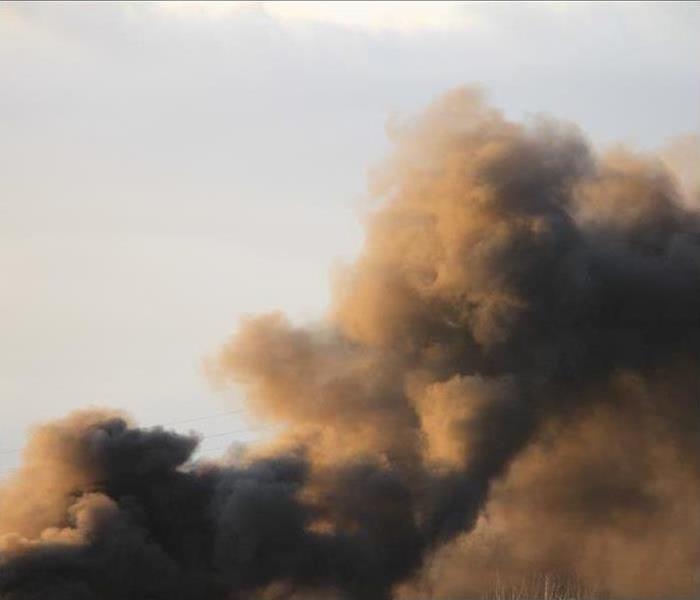 Call SERVPRO to Remove Odors after a Fire in Your McAllen Home!
Call SERVPRO to Remove Odors after a Fire in Your McAllen Home!
Drying Out and Deodorization are Essential Parts of Fire Damage Mitigation
Performing mitigation services to help restore damaged homes in McAllen includes different approaches to the harm a home or business sustains. Two of these steps focus on the secondary results from the event.
McAllen homes that sustain fire damage often end up with standing water and the presence of foul odors. Both of these problems require mitigation, in addition to the extraction of fire-damaged materials and belongings. SERVPRO technicians must remove all of the water used in extinguishing the flames, and also destroy the odors that pervade a residence after a fire. Smells come from the soot that spread, burnt materials, and the water, as well. Steam produced when water hits anything burning also creates a powerful odor by carrying pungent particulates.
We use machines that efficiently pull water out of your home by eliminating water vapor and moisture from the air and absorbent materials. Fans, desiccant machines, and moisture-trapping heated extraction units restore normal dry conditions quickly. Removing such moisture keeps areas of your residence that remained directly unaffected by fire damage from sustaining damage from the water. Microbial infestation and other secondary water damage types can occur in homes that do not receive such desiccation treatments after fire damage.
Air scrubber, outfitted with HEPA and charcoal filters remove still-airborne soot particles, keeping the air clean and odor-free while we work. Restoration of a healthy indoor air quality is crucial for the well-being of occupants. These machines further protect a home after fire damage from the additional risk of exposure to mold spores that quickly flourish after exposure to water used in firefighting efforts. To finish odor control efforts, we often choose to use thermal fogging for its strength in penetrating areas directly invaded by smoke during a fire. We use agents that bind chemically to soot particles and make them too heavy to re-enter the home's air currents and become noticed as bad odors. During the actual work, we can also place hydroxyl generators to neutralize foul odors.
SERVPRO of McAllen works with residents in the R.G.V, in mitigating fire damage in homes and other residential properties. Contact us to help restore your dwelling by calling (956) 631-0348. Our service line is answered 24/7 throughout the year.
A Swift Response Is Crucial When Dealing With Fire Damage In Your McAllen Property
9/25/2019 (Permalink)
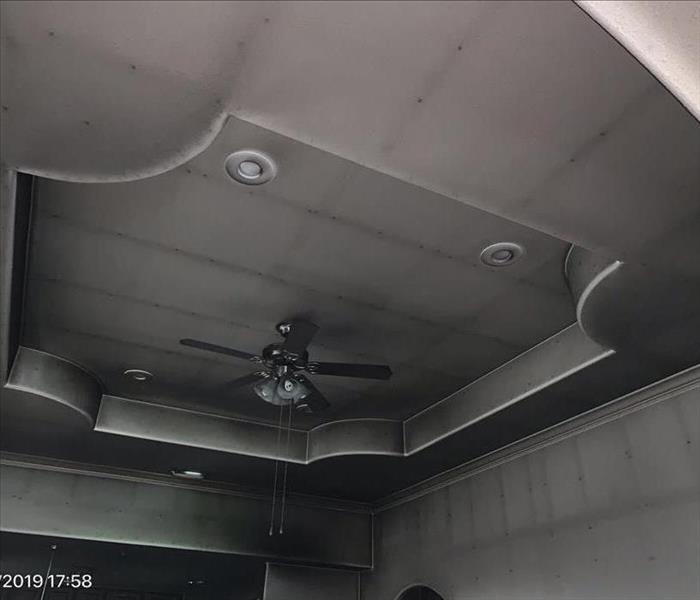 We are faster to any size disaster!
We are faster to any size disaster!
A Quick Response To Fire Damage Helps Contain The Scope And Size Of Property Loss
9/25/2019
Perla Chapa - Marketing Coordinator
Fire is unpredictable, and it can strike your property at any time. Dealing with fire and smoke damage can be an emotionally overwhelming and devastating experience. Fires ruin the things they come into contact with. They also cause secondary destruction from smoke odor, soot residues, and the water used to extinguish the fire. Therefore, you need to clean up your property as soon as you can.
Some problems that can occur if you allow smoke and soot to remain on specific structures and contents of your home include permanent discoloration, staining, and etching. After a fire damages your property, it is advisable to hire restoration professionals to perform the cleanup since this process can be daunting. SERVPRO offers fire restoration services around the clock, and we can clean up your property so you can concentrate on recovering from the event. The fire and smoke damage restoration services we offer include:
Structural cleaning
We inset the affected structures to determine the degree of damage and then use specific equipment and cleaning products to clean and protect the different surfaces in your home. We use state of the art cleaning techniques like dry ice blasting, sanding, and H.E.P.A.vacuuming.
Contents cleaning
It is possible to salvage and restore many items that a fire has not destroyed directly. We can clean and restore items with smoke damage. Our crew inspects the contents of a house to determine the most appropriate cleaning methods. We provide both dry and wet cleaning.
Demolition
Most times, we can clean up structures that soot has destroyed. However, in cases of severe charring, demolition is necessary. Our technicians remove the parts of a house that a fire has ruined like walls, cabinets, and flooring.
Deodorization
Our SERVPRO technicians often use various strategies to remove odors from a home. We can use pairing agents, which are chemicals that combine with odor particles to deal with bad scents. We also use equipment like Ultra Low Volume (ULV) foggers and hydroxyl generators to eliminate odors present in a building.
Pack-outs
We itemize and inventory the fire-damaged contents of a house and take them to our facilities for cleaning and restoration. We maintain accuracy when packing, tagging, and listing contents. We also deliver your inventory after it has been cleaned and restored
After a fire damage emergency, a fast response is critical. SERVPRO of McAllen has trained technicians who can respond to your fire loss with compassion and competency. Contact us at (956) 631-0348 for restoration services.
Three Types of Fire Damage That Affect Homeowners in McAllen
9/24/2019 (Permalink)
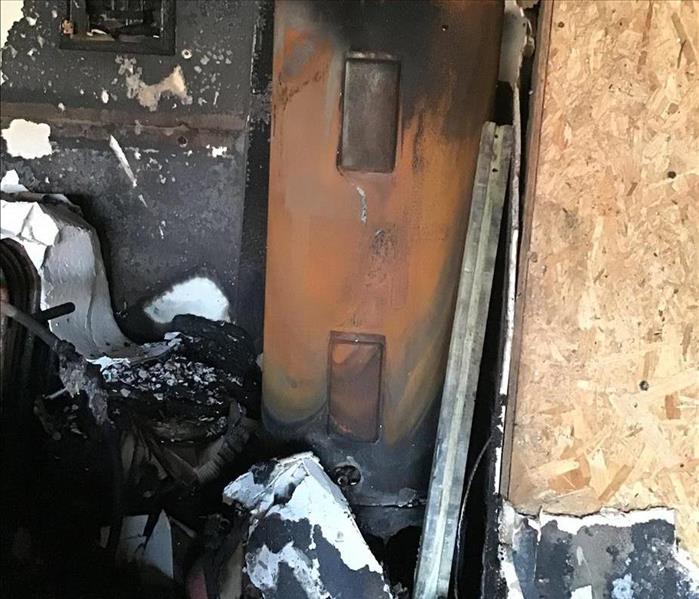 Sometimes your treasures can be restored after a fire. Call SERVPRO today!
Sometimes your treasures can be restored after a fire. Call SERVPRO today!
Things to Take Care of After a Fire Damages Your Milford Property
A fire is devastating, and when it occurs, an immediate response can prevent damage from spreading throughout your home. After a fire loss, you should assess the extent of the damage in the structures and contents of your home. It is also essential to learn if your insurance firm can compensate you for all the relevant destruction.
Fire damage in your McAllen home can be of three types. All three kinds of destruction come with their issues, so it is crucial to understand what they are and how they can affect your property.
Flame damage
Various types of flame destruction can occur based on what caused the fire. For instance, an electrical fire can have a different effect on your house when compared to a fire caused by a naked flame like a match or candle. Improper restoration can cause unseen structural damage or hidden electrical problems. SERVPRO has expertise in restoring homes after any fire.
Smoke and soot damage
The destruction that soot causes is long-lasting and may hang around for weeks or months after extinguishing the fire. The smoke scent can linger on different structures in your house, including ceilings, walls, furniture, and flooring. Smoke turns into soot, and it may discolor surfaces in your home. Some smoke residues can cause some surfaces to corrode. Our technicians can wipe off light-colored painted surfaces, plastic surfaces, tops of furniture with finished surfaces, Formica counter tops and fiberglass surfaces properly to eliminate residues. We can also use air scrubbers to remove the smoke scent from your home.
3rd party damage
A house fire brings about other vulnerabilities and problems. For instance, the water that firefighters used to extinguish the flames can get absorbed in the drywall, flooring, and carpeting. Our SERVPRO technicians can use infrared cameras to check for hidden moisture and then dry the affected areas. Firefighters often use dry chemicals like sodium bicarbonate, monoammonium phosphate, or potassium bicarbonate to extinguish fires. These can leave a corrosive powder on the affected areas. We can clean up the powder quickly to prevent further damage.
After a fire loss, SERVPRO of McAllen is ready to help you deal with it. We can work with you to restore your property to normal quickly. Call us today at (956) 631-0348.
Your Most Burning Questions About Fire Damage Answered!
9/23/2019 (Permalink)
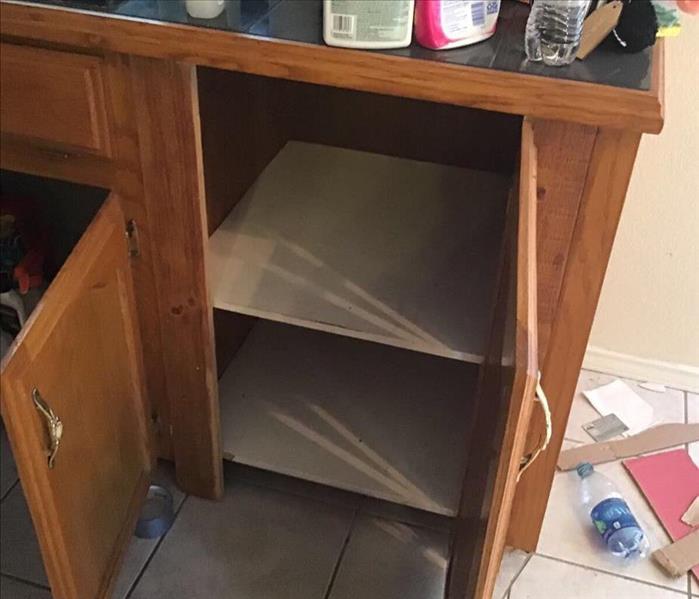 Fire damage to your McAllen home can leave many lingering residues and odors. Contact the professionals at SERVPRO today for help.
Fire damage to your McAllen home can leave many lingering residues and odors. Contact the professionals at SERVPRO today for help.
Odor Removal in Your McAllen Home
9/23/2019
Perla Chapa - Marketing Coordinator
While there are many lingering effects after a fire loss incident in McAllen homes that property owners can overcome with elbow grease and the right focused cleaning efforts, there are other symptoms that ensure that returning a house to preloss condition is a significant challenge. Odor damages, for example, can spread far beyond an ignition source to affect multiple areas of a home, even rooms otherwise unaffected by the disaster. Reducing or eliminating the presence of these harsh scents often requires a higher grade of cleaning agent and units designed for deodorization in the restoration industry.
When overcoming fire damage like lingering odors, SERVPRO professionals like ours must utilize multiple pieces of equipment. The best approach for professional deodorization gets determined by the severity of the condition, the affected materials, and the timeline to protect the rest of the household. While there are multiple units and approaches available to our professionals, the most commonly used by our team are:
These machines utilize both an onboard HEPA filtering system and produce free radicals to break down the molecular structure of foul odors on contact. These units are safe to use around people, pets, and softer materials.
These units (and the larger chambers at SERVPRO facilities) produce a gas comprised of three oxygen atoms. These irregular compounds bond with odor molecules to neutralize them. This practice is not safe to use around humans and pets.
As you might expect from the name, thermal foggers generate heat which vaporizes a compound the fogger can use. In these applications, the fogging solution is a highly effective deodorization agent. This practice is ideal for open areas and softer materials.
- Material Removal/Cleaning
Cleaning can help to noticeably reduce the presence of harsh odors in a fire-damaged area of your home. It is always the last resort of our SERVPRO professionals to allow for material removal and later replacement, and this decision only gets made with areas too severely damaged to preserve.
While there are some aspects of fire damage that homeowners can address on their own when first responders leave the scene, symptoms like odors pose a much more challenging obstacle to overcome. Let our SERVPRO of McAllen team help you make it “Like it never even happened.” Give us a call at (956) 631-0348.
We make fire damage "Like it never even happened".
4/23/2019 (Permalink)
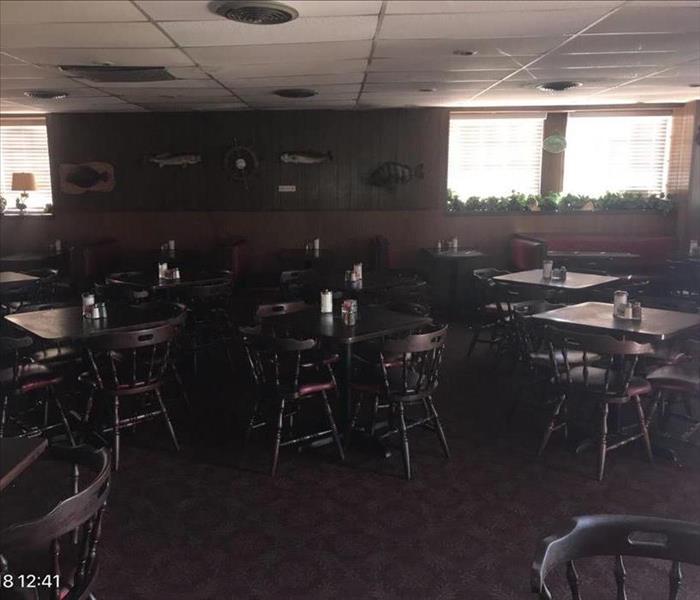 This business was affected by fire damage, and we quickly made it "Like it never even happened".
This business was affected by fire damage, and we quickly made it "Like it never even happened".
Every fire is different, even the smallest fire can cause significant damage. Trust our trained staff to arrive promptly, survey and determine the extent of the damage. We then offer and provide the next steps to getting your home and property secured, through board up, and/or structural stabilization. Fire and the resulting smoke and water damage to your home and property is both devastating and overwhelming. Trust our damage-restoration specialists to inspect and evaluate your circumstances and guide you through every step of the process. We have the experience, expertise, equipment and the manpower to effectively respond and repair your resulting damage. No matter what time or the size of the work to be done, we offer 24-hour emergency and full restoration services, and have over years of experience dealing with fire damage restoration in the Valley.
Ways to Protect your business from Fire Hazards
3/27/2019 (Permalink)
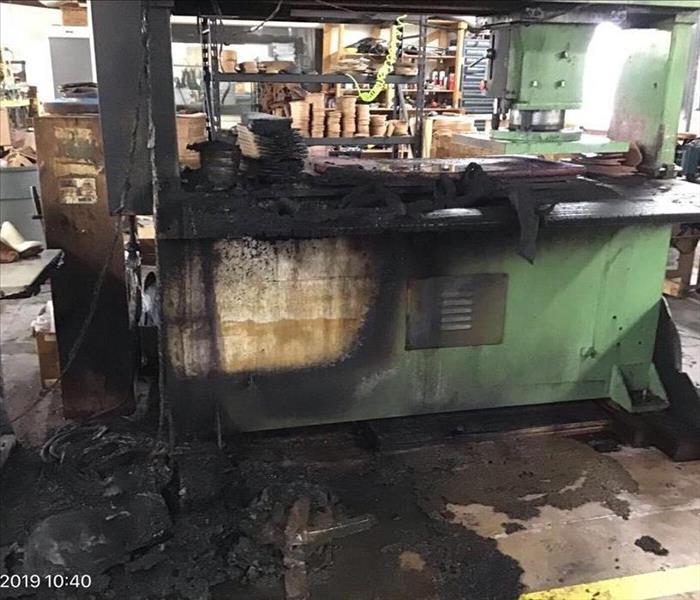 Local Commercial business affected by fire damage.
Local Commercial business affected by fire damage.
Business owners have many things, including plenty of safety factors to consider, regarding risks to their business, staff, and visitors. If you are a business owner, one of those risks you need to spend a little extra time planning for and working toward preventing is a Fire!
Common Causes Of Commercial Structure Fires:
According to the National Fire Protection Association, The leading causes of structure fires in office properties include..:
1. Cooking Equipment- 29% of fires.
2. Electrical Distribution, and Lighting Equipment- 12% of fires.
3. Heating Equipment- 11% of fires
4. Intentional- 10% of fires
5. Smoking Materials- 9% of fires
6. Exposure- 4% of fires
7. Electronic, office, or Entertainment Equipment- 3% of fires
Out of those, Namely three causes accounted for the most property damage are intentional fires, Exposure, and Electrical distribution and lighting equipment fires with 20%, 18%, and 15% respectively.
Protecting your Business:
There are many steps to follow to protect your business from the risks of fires, But focusing on fire risk assessment, Fire prevention, and Staff education, you can help reduce the chance of a fire breaking out. First you need to make sure to assess the fire hazard risks in your facility. In some areas, the local government may even provide a visit from a fire marshal who will help identify these risks and provide guidance on your fire prevention plan. You'll want to make sure that the right fire protection equipment is in place. This includes an automatic sprinkler system, smoke detectors and fire extinguishers on each floor. Most importantly, consider your employees and visitors. Creating a fire plan and reviewing it with your staff will ensure that you are making sure everyone knows what to do in the event of a fire. Conduct fire drills at least once a year to keep that fire safety protocol fresh in their minds, and take time to review evacuation plans and the location of first-aid kit.
Despite best efforts with fire prevention and safety tips, the worst could always happen at your business, if a fire has damaged your business SERVPRO of McAllen is available to help make it "Like it never even happened."
Home Fire Prevention & Safety Tips
1/7/2019 (Permalink)
 Fire safety awareness,
Fire safety awareness,
Fire safety is of very critical importance. Reason being is because fires can strike anywhere at anytime! SERVPRO of McAllen would like to provide you with some of the top tips for fire safety to help prevent a fire from happening in your own home to keep you, and your family safe.
- Install smoke alarms on every level of your home. Inside bedrooms, and outside sleeping areas to alert you in case of any fire that's happening inside your home.
- Test smoke alarms EVERY month! This is very important.
- Make a fire escape plan, and practice the plan at least twice a year.
- If a fire occurs in your home, GET OUT, STAY OUT, and CALL FOR HELP right away.
Prevent a fire from happening in your home by:
- Inspecting heating sources in your home.
- ALWAYS keep the stove and oven clear, and never leave the kitchen unattended while stove or oven is on.
- Maintain cords. Whenever you have finished using any appliance, make sure to unplug the appliance.
- Store flammable products properly.
- Be very cautious with candles. Turn them off after you have finished using it. NEVER leave a candle on overnight.
STAY SAFE! From your friends at SERVPRO Of McAllen.
3 Ways To Escape From A Fire.
1/7/2019 (Permalink)
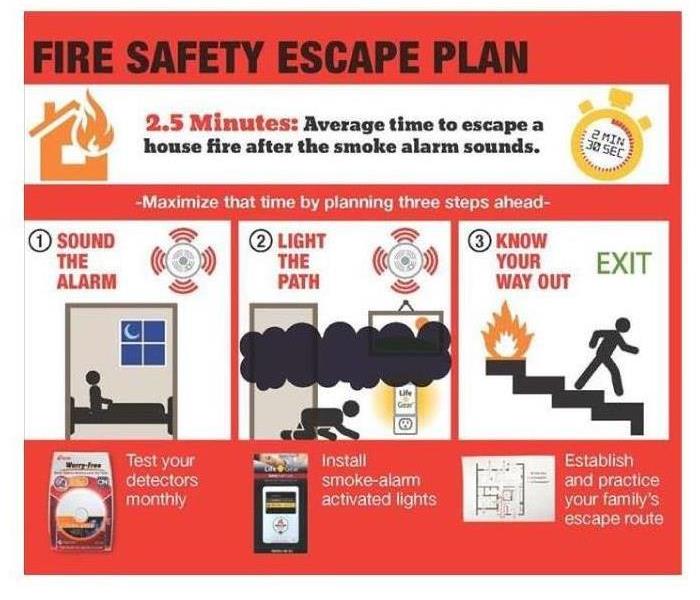 SERVPRO Fire Escape Plan.
SERVPRO Fire Escape Plan.
Remember to always think ahead by Being prepared, having a plan, and practicing that plan. these are essential to escaping a fire. Craft your plan by taking into account your home's particular layout and your household members. Let's look into the 3 different ways you can escape from a fire:
- Have an escape plan and practice it.
Start off by developing a fire escape plan and making sure everyone in your household knows what to do in case of a fire. Your plan should include all available exits from each room, and routes that lead from the room to a safe, open-air space. Be sure to designate a meeting space away from your home.
- It's important that your exit routes do not lead to a closed-in area that would prevent being able to escape.
- Make sure that everyone in your household knows how to unlock or unlatch any doors, windows, gates, or fences.
- Practice your escape plan every 2 months.
2. Plan Around The Abilities Of Everyone in Your Household.
When making an escape plan, Take any handicaps or abilities into account. If you of someone in your household depend on glasses or hearing aids, and will need them in order to find their way out, make sure they're always on a nightstand or other easy access spots.
- It's best for anyone mobility issues to sleep on the ground level of a multi-story home.
- Contact your local fire services non-emergency number and tell them about anyone in your household with special needs that should be kept on file.
3. Stay Low And Crawl To An Exit To Avoid Smoke Inhalation.
Stay as low to the ground as possible while you swiftly make your way to the nearest exit, Especially if there is smoke in the area you're located. Smoke inhalation can cause you to lose consciousness, and the freshest air will be closest to the group since smoke, and toxic chemicals rise. In addition, staying low below the smoke will increase your ability to clearly see your escape plan.
Time Duration of Smoke & Fire Damage
9/4/2018 (Permalink)
Restoration professionals will agree that the longer it takes for the neutralization and cleaning processes to start, the higher the risks for more potential damage and restoration costs. Prolonging the restoration of your home will amplify the effects brought on by the smoke exposure. Here is a timeline of the effects of fire and smoke on a home.
Within minutes – Acid soot residues cause plastics to yellow. Small appliances located close to the source of combustion and highly porous materials (marble, alabaster) will discolor permanently.
Within hours – Acid residues stain grout in bathrooms. Fiberglass bath fixtures, uncoated metals, counter tops, finishes on appliances, and furniture finishes will discolor and tarnish.
Within days – Acid residues cause painted walls to yellow permanently. Metals will corrode and rust; wood furniture and vinyl flooring will require refinishing or replacement. Clothing becomes soot stained and upholstery stains permanently.
Within weeks – Restoration costs will increase dramatically. Synthetic carpet fibers may yellow or discolor permanently. Silver plate is corroded permanently; glass, crystal, china may require replacement due to severe etching and pitting caused by prolonged exposure to acid soot residues.
How Fire Smoke Can Affect Your Health
9/4/2018 (Permalink)
Smoke is a complex mixture of gases and fine particles when wood and other organic matter burn. The biggest health threat from smoke comes from fine particles. They can get into your eyes and respiratory system, causing such health problems like burning eyes, runny nose, and illnesses such as bronchitis. These particles can aggravate chronic heart and lung diseases, and are linked to premature deaths in people with these conditions.
Some people are more susceptible than others. If you have heart or lung disease, you may experience health effects earlier and at lower smoke levels than healthy people. Older adults are more likely to be affected by smoke and children are more susceptible to smoke for several reasons: their respiratory systems are still developing and they breathe more air per pound of body weight than adults.
Smoke can irritate the eyes and airways, causing coughing, a scratchy throat, irritated sinuses, headaches, stinging eyes and more! With a heart or lung disease, smoke will make your symptoms much worse. Heart disease patients can experience chest pain, palpitations, or fatigue. Lung disease patients may not be able to breathe as deeply or as usual, and they may experience symptoms such as coughing, phlegm, chest discomfort, and wheezing. When smoke levels are high enough, everyone (healthy or non-healthy) can experience some of these symptoms.
At SERVPRO of Mcallen we are trained and certified by IICRC to mitigate and clean structures affected by fire or smoke, to request an inspection call us at 956-631-0348 or go to www.SERVPROmcallen.com
Kitchen Safety: How to Put Out a Grease Fire
4/23/2018 (Permalink)
 Grease Fire
Grease Fire
Cooking doesn't normally present a lot of danger. You might nick your finger while chopping vegetables or manage to burn a pan of roasting potatoes, but in terms of actual danger to ourselves or our homes, not so much. Except for grease fires. Do you know what to do if your cooking oil catches fire?
A grease fire happens when your cooking oil becomes too hot. When heating, oils first start to boil, then they'll start smoking, and then they'll catch on fire. Most vegetable oils have a smoking point around 450°F, while animal fats like lard or goose fat will start smoking around 375°F.
The very best safety is prevention. Whenever you're heating oil for pan-frying or deep-fat frying, stay in the kitchen. Use a heavy pot with a lid and clip a thermometer to the side so you know the temperature of the oil.
Keep an eye on the oil as it's heating. If you see wisps of smoke or smell something acrid, immediately turn down the heat or remove the pot from the burner completely. The oil won't immediately catch fire once it starts smoking, but smoke is a danger sign that it's well on its way to getting there.
If the worst happens and your oil does catch on fire, do the following:
- Turn the Heat Off - Don't try to move the pot. You might accidentally splash yourself or your kitchen with burning oil. And that would be bad.
- Cover the Pot with a Metal Lid - Fire cannot exist in the absence of oxygen. With the lid on (and the heat off), the fire should quickly consume all the oxygen and put itself out. Use a metal lid since glass will shatter.
- Pour on Baking Soda - Baking soda will extinguish grease fires, but only if they're small. It takes a lot of baking soda to do the job.
- Spray the Pot with a Class B Dry Chemical Fire Extinguisher - This is your last resort, as fire extinguishers will contaminate your kitchen. Still, it's better than the alternative if the fire is getting out of control.
- Get Out and Call 911 - If the fire does break out of control, don't try to be a hero. Get out and find a phone to call 911.
Whatever you do, DO NOT do the following:
- Do Not Use Water - Pouring water can cause the oil to splash and spread the fire. The vaporizing water can also carry grease particles in it, also spreading the fire.
- Do Not Move the Pot or Carry It Outside - Throwing the pot outside might seem logical in the frenzy of the moment. But trying to move the pot might splash burning oil on you, your home, and anything outside.
- Do Not Throw Any Other Baking Product On the Fire - Flour might look like baking soda, but it won't react the same. Only baking soda can help put out a grease fire.
Phew, now that we're clear on all of that, hopefully you'll never be in a situation where you have to actually use this advice. But, if you do happen to go through such an event, feel free to call on the cleaning experts at SERVPRO of Mcallen. Our highly trained and certified technicians will clean and deodorize your structure to preloss condition. We will work diligently to make your fire event “Like it never even happened.”
Be safe, fellow cooks!
Ultrasonic Cleaning 101
3/7/2018 (Permalink)
What are ultrasonic waves?
Ultrasonic cleaner waves are sound waves transmitted above 20,000 Hz (20 kHz or 20,000 cycles per second), or higher than the frequency detectable by humans. Sound waves are created by the vibration of an object, which causes the air molecules around it to vibrate. These vibrations cause our eardrums to vibrate, which the brain then interprets as sound. When the original vibration is very fast, so are the sound waves, and the pitch of the sound created is too high for the human ear to hear.
Ultrasonic cleaners work in a very similar way to a loud speaker, except the ultrasonic cleaner waves travel at a much higher frequency and through water instead of air. A high-frequency electronic generator that creates ultrasonic waves is connected to a diaphragm, a flat or cone-shaped structure similar to the visible cone-shaped portion of a loudspeaker. The generator vibrates the diaphragm at a specific high frequency, usually between 25 and 170 kHz, inside a specially designed water tank. The ultrasonic cleaner waves created cause the water molecules to vibrate rapidly, creating alternating waves of compression and expansion within the water. During the expansion phase, or rarefaction cycle, the liquid is torn apart, creating cavitation bubbles. These bubbles are where ultrasonic cleaning technology is born.
How does ultrasonic cleaner technology clean?
Cavitation bubbles are vacuum cavities as tiny as red blood cells, or about 8 thousandths of a millimeter across. They are so small that it would take 1,250 of them lined up in a row to reach 1 cm long.
Under pressure of continuous vibration, these bubbles stretch and compress at a fast rate. Once they reach a certain size, as determined by the frequency and strength of the sound waves produced, the bubbles lose structural integrity and collapse violently. When these implosions happen near a surface, the bubbles emit high-powered streams of plasma that travel at more than 500 miles per hour and collide with, agitate and remove even very tiny particles and substances from that surface.
In an ultrasonic cleaning machine, this happens millions of times per second, but because cavitation bubbles are so small the process is both highly effective and very gentle. Ultrasonic technology can be used to clean metals, plastics, glass, rubber and ceramics. It effectively removes a wide variety of contaminants, even if present only in trace amounts, including dust, dirt, rust, oil, grease, soot, mold, carbon deposits, polishing compounds, wax, pigments, lime scale, bacteria, algae, fungus, fingerprints and biological soil.
These contaminants typically are removed even if they are tightly adhered to or embedded onto solid surfaces, or if they are in remote cracks or tiny crevices of an object. For this reason, items usually do not need to be disassembled before being put safely in an ultrasonic cleaning unit.
Technology at your disposal
This technology is part of SERVPRO of Mcallen’s cleaning arsenal. We have certified cleaning technicians that can tackle even the most contaminated fire-soot contents. In the event that you go through a Fire Loss, call the experts at SERVPRO of Mcallen to bring your contents back to life and make it “Like it never even happened.”
How Can Fire Damage Be Harmful To Homeowners?
11/10/2017 (Permalink)
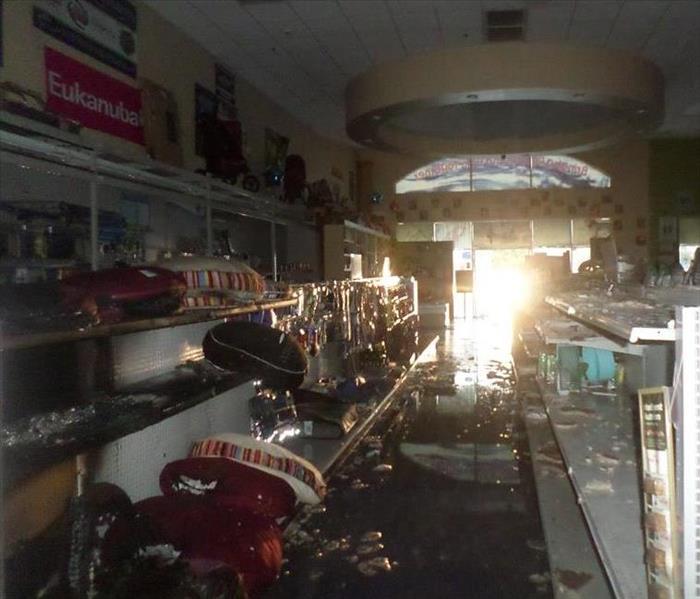 Fire Damage
Fire Damage
Some of the biggest challenges associated with fire damage occur after the flames have gone out. During combustion, water vapor and intense heat are generated, both capable of causing extreme destruction. On top of this, smoke and soot will result in ongoing problems as they both contain toxic chemicals and pungent odors. Just how bad the odors and toxic effects are will depend on the composition of the fuel used for combustion, the intensity of the heat, and the length of time the fire ran before it was extinguished.
Plastics and other synthetic materials can leave behind chemical residues that are harmful if inhaled. Wood smoke, usually the greatest contributor to the amount of smoke in the building, contains methane, carbon monoxide, benzene, sulfur dioxide, formaldehyde, formic acid, acetic acid, and traces of heavy metals. This toxic soup will cause major problems for anyone who inhales the smoke or comes in contact with surfaces harboring smoke residue. Soot and smoke particles have a tendency to settle on carpets, furniture, countertops and walls in the hours following combustion. Before the flames go out, they will send smoke throughout the home, into ductwork, and into wall cavities. In short, there may be no place in the building untouched by smoke, and its presence means trouble.
Smoke particles are incredibly small and may be smaller than .01 microns in size. This is typically too small for standard residential air filters to catch. If the smoke particles are allowed to settle inside the home’s walls, they will create odors that are difficult to track down. Smoke is also acidic in nature, so it will slowly deteriorate various materials within the home. What this means is that a homeowner should contact SERVPRO of McAllen to mitigate as soon as possible. Acting quickly is the best defense in reversing the damage.
Removing smoke and soot requires the proper machinery and expertise. Homeowners should only consider professionals such as SERVPRO of McAllen; SERVPRO is certified through the Institute of Inspection, Cleaning and Restoration Certification, or IICRC. This agency has overseen the certification of fire damage restoration companies for decades and is responsible for regularly updating the best practices in the industry. Technicians with IICRC certification are aware of the most advanced techniques and technologies in the industry. They are among the most knowledgeable members of their field.
During restoration, the technician will need to remove any items that have been destroyed and address any standing water left behind. Pooled water can foster the growth of mold and mildew in carpets and other textiles, so it must be removed quickly. The technician will also have an arsenal of counteractants capable of breaking down any soot or smoke they come in contact with. This is handy for removing ash and soot residue left behind on surfaces. Neutralizing odors left behind will be more difficult, but new methods, including thermal fogging or ozone treatment can break down smoke particles and force odors to dissipate.
It may seem like life will never return to normal following a disastrous fire, but with the help of SERVPRO of McAllen, a family can get back on track before long.
Soft Contents Cleaning By SERVPRO Of McAllen
10/24/2017 (Permalink)
 Esporta system
Esporta system
Cleaning Soft Contents is a vital part of the disaster restoration process. Quickly and carefully processing contents improves claim process times.
Change is and will always be a part of life. Throughout history, we have seen examples of those who embraced change and remained relevant, and those who rejected change and became irrelevant.
The insurance restoration industry has seen its fair share of change over the last decade, part of these changes is adopting new technologies, and one of them is the Esporta iS4000 Wash System.
The Esporta Wash System is capable of decontaminating soft contents from all categories of losses; including sewage, mold and can restore damage caused by smoke and soot from a fire. The decontamination efficacy (this means how well it removes the contaminants) has been validated by numerous third party laboratory tests performed by leading hygienists, universities, and industry consultants.
The Esporta Wash System utilizes hydraulic action to force both organic and inorganic contaminants out of the objects to be cleaned. The force applied can be compared to the force of waves crashing against the sand on a beach.
This system is specially designed, scientifically tested and patented. It can’t be found anywhere else. Due to this technology, the Esporta iS4000 restores 90% of soft contents damaged by odor, soot, grime, mold and mildew.
Other traditional washing machines work on a basic principle of using the mechanical energy of an agitator, paddle, or tumbling action to wash.
The Esporta iS4000 cleans 90% of all damaged soft contents. These soft contents include the homeowners clothing, bedding, outerwear, pillows and stuffed animals. It includes leather items such as shoes, boots, belts, purses and jackets. Plus the full range of sports equipment, helmets, rollerblades & ski boots. Even ceramic collector dolls can be held stationary for cleaning.
What types of damage and contamination can SERVPRO of McAllen restore?
1.-Category 1, 2 and 3 water damage
2.-Heavy smoke and soot
3.-Mold
3.-Bio waste contaminated goods
SERVPRO of McAllen has tested with an ATP surface swab that has verified that Esporta Restoration’s Wash System restores contaminated items to FOOD GRADE CLEAN by removing 99% of contaminants.
What Type of Items Can Be Restored?
1.-Leather goods of all kinds
2.-Shoes
3.-Purses
4.-Jackets
5.-Laundry of all kinds
6.-Wash and fold
7.-Press and hang
8.-Household goods of all kinds
9.-Sleeping bags
10.-Pillows
11.-Comforters
12.-Stuffed animals
13.-Unique articles, such as sports equipment
A wide variety of other articles
How will you benefit?
Customers benefit from 48 to 72 hour turnaround time on emergency items, the recovery of sentimental items, a simpler and faster claim settlement and a satisfaction guarantee. This results in delighted customers, and insurance companies benefit from significantly reduced claim settlement costs.
How To Remove Soot Damage From Household Surfaces
4/10/2017 (Permalink)
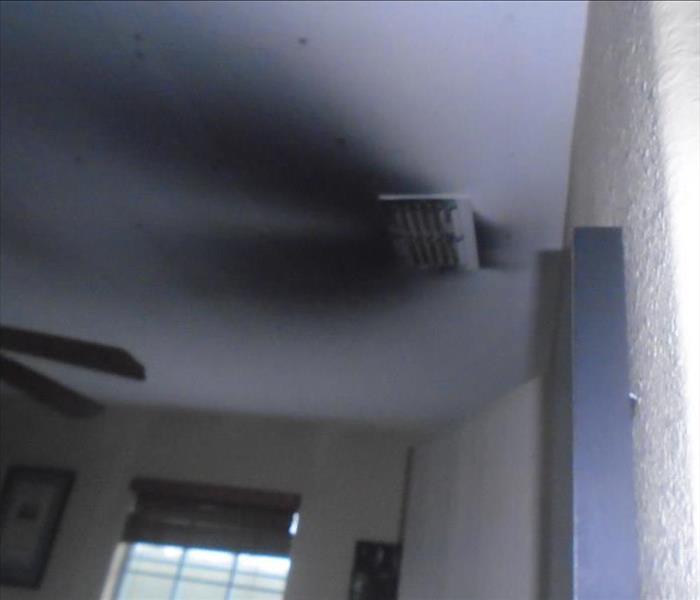 Soot on Structure
Soot on Structure
Fires are often a comforting sight during the winter as fireplaces and candles can provide warmth during the freezing temps. But with this type of warmth comes a hidden danger to your home; Soot. Soot is a black residue that is left behind when various materials are burnt such as plastics, synthetics, foam and wood. Depending on the material burnt, the soot can have a damaging effect on your walls. This precarious clean up requires precise attention. While it is best for professionals to clean up soot damage, you can make the cleanup process easier by following these safety guidelines.
Removing Soot: Always Be Concerned about Safety
Soot is easily transferred onto various surfaces so ensuring it doesn’t spread is imperative to the cleaning process. To protect your walls, follow these protocols before the professionals arrive:
- Refrain from touching anything during the first inspection of the room. This prevents accidental soot transfer to unaffected rooms and surfaces.
- Always wear protective gear, such as gloves, masks, and long clothing that covers the skin when working in rooms affected by soot damage.
- Keep the room properly ventilated to minimize inhalation of the soot particles.
- Clear unnecessary debris from the room to allow for easier cleanup.
Soot Cleaning and Removal
It is important to use proper cleaning methods to remove soot from your walls, ceilings and surfaces. Improper cleaning can cause the damage to spread or get worse. The first thing many homeowners think to do when cleaning is use basic soap and water, accompanied with a sponge. Always test in a small, discreet location, to see if it incurs any damage. When in doubt, always call SERVPRO of McAllen to avoid serious damage.
When soot is caused by high oxygen fires, using a dry-cleaning sponge or chemical dry sponge is the best method for cleanup. If you attempt a wet method, the soot will smear, leaving a hideous stain. In comparison, low oxygen fires are best met with the wet sponge cleaning method.
When vacuuming soot residue from your surfaces, always hold the nozzle at least one half inch away from the area. Avoid contact with the surface because your touch can smear the soot.
Fire Damage Restoration Process- Start to Finish
3/13/2017 (Permalink)
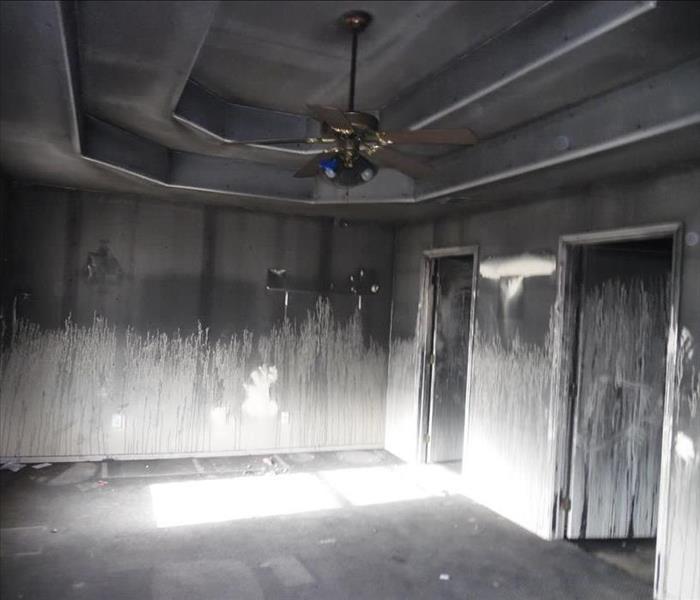 Residential Fire Damage
Residential Fire Damage
Each fire is different and every home requires its own specific approach, but the following is the general process we follow in a typical fire damage restoration situation:
Emergency response. When you make your call to us, the restoration process begins. Our customer service representative will ask the right questions so that we can respond quickly and bring along the right resources and equipment.
Inspection and assessment. We inspect the impacted area and adjoining rooms to find out the extent of the soot, smoke and other fire damage, then we can develop our plan of action.
Securing the structure. Preventing further damage is essential, so we take immediate action to board up broken windows, shore up damaged walls and put tarps over damaged sections of the roof.
Water removal. When water damage is present, we immediately start water removal. Dehumidifiers and air movers are used to get all the water from your home and complete the drying process.
Surface soot and smoke removal. Using special equipment and time-tested techniques, we get rid of soot and smoke from the ceiling, all walls and other hard surfaces.
Cleaning and disinfecting. Restorable items require cleaning and sanitizing. A variety of cleaning products and techniques are used to accomplish this as appropriate. This process includes odor removal using foggers and industrial-strength air scrubbers.
Restoration. Getting things back to normal is the final step in the process. This can involve small repairs, drywall replacement, new carpet installation, painting and more. Major construction may sometimes also be required.






 24/7 Emergency Service
24/7 Emergency Service
















